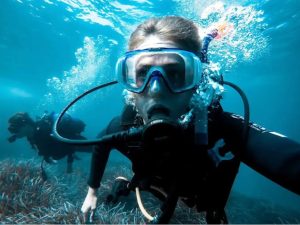How Deep Can You Dive? Before Being Crushed to the Death?!

Have you ever thought “How deep can you dive?” Today, you’re going to find out how a human being can swim down to the wreck of the Titanic and how an ocean dive can boil three men alive and make a fourth turn inside out.
Here is the list of the content we are going to talk about regarding “How Deep Can You dive”:
- A hypothetical diver، Mark!
- His dive into the depths of the water
- Changes that he experiences
- Some records regarding diving
- Real facts and sad happenings about diving
The hypothetical diver، Mark!
But first… Meet Mark. Mark is renowned for his obsession with the ocean, a love that’s been with him since childhood. Even now, he longs to live on the sea and daydreams of what it might be like if he could breathe underwater. All of his life, his closest friends have always teased him about his ocean mania.
But this year, for his 30th birthday, they have lovingly planned a diving trip, but not just any diving trip. They were heading out into the Pacific Ocean, east of the Mariana Islands, to take him to the Mariana Trench. It’s the diving trip of his dreams. Before the trip, Mark had spent months preparing, focusing on leg and core workouts. He was thinking about “How Deep Can You Dive?” all the time.
He practiced holding his breath for long periods. On the day his friends told him of the trip, he decided that he was going to dive as deep as his body would physically allow him to go as a result of his previous thoughts about “How Deep Can You dive”. He successfully kept this secret from his friends. He knew they would try to talk him out of it. They had woken up early in the morning and set out on the ocean blue.
Mark suits up in his scuba gear, while still not telling his friends about his plans. He knows that they would try to stop him from what his friends would call a foolish endeavor. Mark dives into the ocean, immediately swimming down. Now, the human body is accustomed to air pressure, but as you go deeper into the ocean depths, the pressure around you increases from the weight of the water above you.
Mark dives!

It is necessary to know that before thinking about “How Deep Can You Dive”, first, consider this math: While this may not be exact, it’s believed that for around every 10 meters, or 33 feet, the pressure increases by 1 atmosphere. That’s about 14.7 pounds per square inch. When it comes to deep-sea diving, pressure is everything.
| pressure | depth | |
| increases by 1 atmosphere | every 10 meters, in water |
1 |
| increases by 1 atmosphere | every 33 feet, in water |
2 |
Changes start!
A few feet down, Mark quickly notices a change in pressure. The first giveaway is the increased pressure he feels in his eardrums due to the increase in hydrostatic pressure. Mark’s body adjusts to the changes as he continues to go further and further down. He quickly leaves his friends far behind him. Mark discovers that, like a lot of people, he can safely dive down to 60 feet.
His heartbeat has slowed by 25%, and his body begins to move blood to his most vital organs. It prioritizes the organs that will keep the body functioning as a way to cope with the pressure change. You may have heard of this as peripheral vasoconstriction. It’s also common when someone is exposed to cold climates.
In those cases, it’s to prevent the body from losing heat. It’s important to remember that oxygen becomes toxic at greater depths thanks to the high pressure. Normally, without proper equipment at this depth, people at 184 feet will find that the air has become toxic. But Mark prepared and managed to swim past this depth thanks to his equipment.
Do you want to know “How deep can you dive”? At around 100 feet, Mark’s body has to fight against 4 atmospheres of pressure. The more pressure that’s applied, the more gas and oxygen in the body decreases. He continues down until he reaches 436 feet, the world record for free diving.
An incredible record!
The last time someone had reached this depth was Alexey Molchanov in Villefranche-sur-Mer, France, on June 30, 2023. Alexey holds a great record about “How Deep Can You Dive”.

Molchanov had also managed to do it in a single breath, holding his breath for 4 minutes and 42 seconds. When Molchanov was asked about his dive, he said, “My dive felt good, but I’m tired! Overall, I felt strong, I felt clean as well, but it’s not my favorite discipline.” The record had been previously held by Arnaud Jerald, who had reached 400 feet. Our Mark has decided to forgo holding his breath.
If he wants to get as low as he can, he’s going to have to rely on being able to breathe the entire way down. As Mark continues his descent, his lungs will continue to contract under the pressure of the water. He reaches 700 feet, and his lungs continue to shrink. It makes it more difficult to breathe, but not impossible.
If you like to know more about his record, you can check this!
Stay with us to see how deep can you dive. Even though our bodies are up to 60 percent water, they weren’t built for the murky depths of the ocean. When it comes to humans scuba diving, it’s more about how much the water pressure will crush the air spaces within the human body first than how much water you have within you.
His friends are panicked!!!
While his friends begin to panic, as he’s going much lower than planned, Mark is undeterred. Aware that panic is what kills many divers, Mark keeps his cool. When a diver panics, they’re more likely to try to make a beeline back to the surface.
While panicking, they will often be at risk of drowning, lung over-expansion injuries, and decompression sickness. All of these can cause serious injury or death Two of Mark’s friends, Corinne and Steve, try to reach Mark, but both of them panic. Steve turns back after 40 feet, and Corrine is only able to follow him down to 60 feet before she quickly turns around and swims back to the surface.
A big mistake!
For people who are obsessed with “How Deep Can You Dive” and want to try it, this is a big mistake. Poor Corrine and Steve have given themselves the Bends. The bends, also known as decompression sickness or generalized barotrauma, occur when a person experiences a rapid decrease in the pressure around them. It can be air or water pressure, but people are far more familiar with it in a scuba diving setting. It’s significantly rarer on a pressurized aircraft.

When diving with compressed air, divers are breathing in extra oxygen and nitrogen. The nitrogen dissolves in a diver’s blood, so if you swim back to the surface too quickly, you don’t give your body enough time to clear out the nitrogen in the bloodstream. This leads to the gas forming bubbles in your tissue and blood, causing decompression sickness.
If there is still passion in your mind about “How Deep Can You Dive” and you would like to try it one day, you will regret it if you stay with us!
Steve’s case is far more mild, or Type I. It will cause pain in his body, especially in the joints of his arms and legs. In some cases, it can cause pain in the back and muscles, or the location of the pain can be difficult to pin down. Steve also gets some of the less common symptoms, which are itching, skin mottling, rashes, swelling of the arms, and extreme fatigue. Fortunately, it’s not life-threatening, but it does make him miserable.
Corrine, sadly, has Type II, which usually results in neurologic symptoms, and she has gotten the worst of them all, it seems. As Corrine’s spinal cord is particularly vulnerable, she suffers from numbness, tingling, and weakness in her arms and legs. Her brain is also impacted as she has a headache, trouble speaking, and double vision, all of which lead to confusion.
Loss of consciousness is rare, and, in Corrine’s case, she remains conscious. Corrine’s inner ear is damaged, giving her severe vertigo and ringing in the ears. This can lead to hearing loss, but she doesn’t succumb to this particular symptom. Corrine has gas bubbles that have traveled through her veins to her lungs. She’s struggling with chest pain, and coughing, and it’s become progressively more difficult to breathe.
Yes! These are all the negative effects of diving in deep water. Anyway, there is more about how deep can you dive!
In some cases, this can cause shock and death in someone with the bends. If Corrine doesn’t receive treatment immediately, all of the damage could become permanent, and she may even die. Rudy, yet another one of Mark’s friends, isn’t the brightest, but he has a heart of gold. Desperate to help his friend, Mark, Rudy dives down and makes it to 300 feet.
Not planning, Rudy realizes he has an insufficient amount of gas. There is conflicting information on just how common it is to die from inadequate gas supply.
According to an ANZ survey, it’s around 56%, while a survey conducted by DAN, it’s 41%.
Rudy is far from the first person to run out of gas during a dive.

Many die due to trying to conserve oxygen for fear of running out of air before reaching the surface. In Rudy’s case, he is not able to make it back to the surface in time, and he drowns. John, Mark’s oldest friend, also tries to save his buddy. Sadly, he is a victim of one of the most common causes of death for divers.
Another mistake!
You are reading about “How Deep Can You Dive”, you can also see this video about it:
90% of divers die with their weight belts on. When John is forced to turn back due to low air supply, he forgets to remove his weight belt. The extra weight makes it too difficult for him to swim to the surface, drowning before anyone can get to him. Mark’s friends might have faired better if they had read Diving Medicine for Scuba Divers by Dr. Carl Edmonds, Dr. Bart McKenzie, Dr. Robert Thomas, and John Pennefather.
In a chapter titled Why Divers Die, they discuss that diving fatality data reveals that 80% of divers were alone when they died. They recommend a buddy system, which Mark’s friends did not implement. If you have a buddy with you, they can assist you when things go wrong.
Mark is also aware that when a human is crushed underwater, it’s often due to a sudden change in pressure. Knowing this, he has given his body a chance to adjust the entire way down. He also opted out of wearing a pressure suit. Since the water can touch his body, all Mark has to focus on is equalizing his air spaces.
If he can continue to equalize his air spaces, like his lungs, with gas, he can prevent being crushed. There are some devastating examples of a sudden change in pressure underwater, though. There is another story about “How deep can you dive?”:
Further sad story in this regard!
On November 5th, 1983, at four in the morning, five men lost their lives in the Byford Dolphin accident when a compression mechanism malfunctioned. The Byford Dolphin was a semi-submersible drilling rig that was, at the time, stationed in the Frigg gas field, a natural gas field in the Norwegian sector of the North Sea.
William Crammond was in the middle of a routine procedure when he connected the diving bell to the living chambers of the rig that held two divers each. Normally, the diving bell wouldn’t be detached from the living chambers until the chamber doors were shut.
Sadly, the diving bell detached before they could finish closing, leading to an explosive decompression. The air pressure went from 9 atmospheres to 1 atmosphere. In the rush of air from the chamber, Crammond was killed by the diving bell flying out. It also critically injured his coworker, Martin Saunders. The divers who were in the living chambers met a horrific fate.
It’s said that three of the men, Edwin Arthur Coward, Roy P. Lucas, and Bjørn Giæver Bergersen, were boiled alive from the inside out. The nitrogen in their blood transformed into gas bubbles, killing them instantly. The fourth diver, Truls Hellevik, was in front of the partially opened door when the diving bell detached, and he was sucked out.
But the opening was so narrow that it tore him open and scattered his internal organs onto the deck of the ship. Mark reaches a depth once thought impossible: 12,500 feet. The Titanic also lies at 12,500 feet below sea level. This would make the pressure 380 atmosphere.
You could compare that to having an elephant standing on every inch of your body. Still, Mark’s body is not crushed. The pressure is immense, but he can survive it. It was once believed to be impossible to scuba dive at the Titanic’s depth until 2018.

According to Cameron James, the extreme diver who went down to the Titanic, “You can’t just jump off a boat and swim down. It’s over 4 km deep and the water is very cold. You’d be hypothermic before you got even part of the way.”
Yes, we do recognize the amusing coincidence of the extreme diver who made it to the Titanic being called Cameron James – The perfect opposite of director James Cameron, who made the movie Titanic back in 1997. Life’s full of funny little moments like that.
stay with us about “how deep can you dive”; Anyway, back to our friend Mark. If Mark had been just an ordinary person, he would have frozen to death, but Mark seems to be running on pure spite and dreams at this point. James goes on to explain, “The pressure at that depth is immense. You can inhale one tank of air in a single breath, so I had to carry a lot of tanks with me, and breathe very, very, slowly.”
To survive at this depth, Mark will have to follow James’ example. He’ll have a lot of tanks at his disposal, and he’ll be careful to watch his breathing.
They were so immense they nearly sank the ship. So, if Mark lets one loose, his surviving friends may witness a terrifying amount of bubbles coming to the surface. If they aren’t careful, Mark’s expedition may capsize their boat and give Mark nowhere to return to, if he happens to survive the ordeal that is.
But it would be difficult for Mark to make it down this far. In a lot of cases, most people’s lungs collapse before they even reach 1000 feet. However, in 1992, a French diving company called Comex conducted several experimental dives.

Thanks to saturation diving, they were able to send a diver down to 2,300 feet, or 701 meters, for two hours. This diver was under 71.1 atmospheres of pressure at this depth. Saturation diving allows divers to breathe in a gas that is dissolved by the body’s tissues until they are fully saturated, meaning they can’t absorb any more of the gas.
Full saturation generally takes about 24 hours. Saturation divers can spend days or weeks down at ridiculous depths in the ocean. The majority of saturation diving happens between 65 and 1000 feet. To safely decompress from those depths, it takes one day per 100 feet of seawater plus a day. So, if you were to dive to about 650 feet, it would take you eight days to decompress safely.
That means it’ll take Mark a lot longer to go up than it did to go down. So what if Mark’s lungs didn’t collapse? How deep would he have to go until his body was completely crushed?
Fortunately for Mark, human bones crush at around 24,600 pounds per square inch. He would have to dive 22 miles down before the ocean had enough strength to crush the bones in his body.
The Mariana Trench is the deepest part of the ocean, and it reaches 11,034 meters, which is 36,201 feet or 7 miles. It’s more likely that Mark would drown or die from too much pressure on his lungs than being crushed completely. For his entire body to be crushed, he would need to be able to go three times deeper than the Mariana Trench.
So, besides “How Deep Can You Dive”, let’s see how deep can Mark go. Admittedly, research on this is spotty, and no one is entirely sure exactly at what depth the pressure of the ocean will crush your lungs, especially since everyone is different. Our Mark manages to keep his lungs from being crushed most of the way down and makes his way to the bottom of the Mariana Trench.
Are you still curious about “How Deep Can You Dive” and like to try it? We do not think so!
The end of Mark’s journey!
Sadly, this is the end of our story about “How Deep Can You Dive”. This is where we will likely see Mark meet his end. While it may not be enough to crush his body, it’s enough to cause his lungs to collapse. Probably, he would never think about “How Deep Can You Dive” again! At the bottom of the Mariana Trench, Mark not only faces extreme water pressure, but he also faces temperatures of below 0 degrees Celsius, darkness, and all of the strange wildlife it has to offer.
Betrayed by his first love, the sea itself, Mark’s body succumbs to the pressure and floats to the bottom of the Mariana Trench for the fish to feast upon. Although he has never been granted the ability to breathe underwater, he is now free to become one with his one true love, the ocean. Certainly, his mind is free of the concerns of “How Deep Can You Dive”.
Do you just love a happy ending? Unfortunately, this dangerous action about “How Deep Can You Dive” cannot have a happy ending!
This is the end of our article about ‘how deep can you dive’, we hope you liked it. Tell us in the comments! Also, do not forget to see the video mentioned above to complete your information about how deep can you dive!
 Arab24 اخر اخبار الوطن العربي
Arab24 اخر اخبار الوطن العربي
